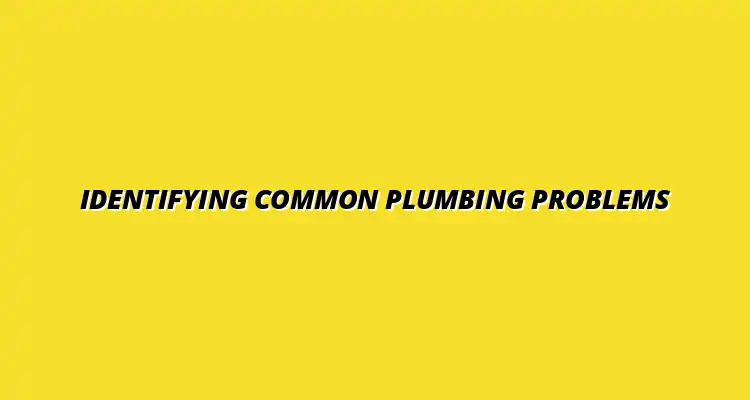
- Plumbing Basics
- Feb 17
2024-12-26
Plumbing issues can sometimes feel overwhelming, especially for homeowners who may not know what to look for. Common plumbing problems can range from minor annoyances, like a dripping faucet, to major emergencies that require immediate attention, such as burst pipes. It's important to familiarize yourself with these issues to maintain a safe and comfortable living environment. For example, learning how to fix a leaky faucet can save you money and prevent bigger problems down the line.
Neglecting plumbing issues can lead to not just inconvenience, but also more serious damage over time. Water damage can compromise the structural integrity of your home and result in costly repairs. By addressing plumbing problems promptly, you can save money and prevent more serious complications down the road.
In residential homes, plumbing problems are not just common; they are often expected due to age, wear, and tear. Some of the most frequent issues include leaks, clogs, and low water pressure. Understanding these plumbing problems helps homeowners take proactive measures to prevent them from escalating. A good understanding of residential plumbing systems is a great first step.
Addressing plumbing issues as soon as they arise is crucial for several reasons. First, unresolved leaks can lead to increased water bills, affecting your budget. Additionally, the potential for mold growth increases, which can pose health risks for you and your family.
Another reason to act quickly is that minor plumbing issues can become major headaches if left unchecked. A small leak can worsen into a burst pipe, causing significant damage and expensive repairs. By staying vigilant, you can ensure that your home remains safe and your plumbing system functions optimally. For emergencies, consider finding a reliable local plumber like those available in areas such as Deritend, Birmingham.
When plumbing problems go unresolved, they can disrupt daily life in numerous ways. For instance, a running toilet can waste a lot of water, raising your utility bills significantly. Furthermore, clogged drains can hinder your ability to use sinks, tubs, or toilets, leading to frustration and inconvenience.
Leaks and drips can be sneaky and often go unnoticed until they cause serious damage. They can occur in various places, like under sinks, behind walls, or even in the yard. Identifying these leaks early is essential to minimize damage and repair costs.
There are several signs to look for when checking for leaks, which can save you both time and money. If you notice any of these indicators, it might be time to investigate further or call a professional. Regular bathroom plumbing maintenance can help prevent many common issues.
Water leaks can manifest in various ways, and it's essential to be attentive to the signs. Common indications of leaks include:
By recognizing these signs early, you can address issues before they escalate into larger problems. It’s always a good idea to routinely check your plumbing fixtures for any abnormalities.
Aside from water bills and damp spots, there are several visual indicators to keep an eye on. Look for:
These signs can help you pinpoint potential issues before they become major headaches. If you notice any of these visual indicators, it’s best to take action quickly to prevent further damage.
Using a water meter is an effective way to identify hidden leaks in your plumbing system. Start by turning off all water-using appliances and fixtures in your home. After ensuring everything is off, check your water meter reading.
Wait about an hour and then check the meter again. If the reading has changed, you likely have a leak somewhere in your system. This method is simple and can save you from costly repairs later on!
Clogged drains are another common plumbing problem that can lead to frustrating situations. They can slow down your daily routines, making simple tasks like washing dishes or showering inconvenient. Understanding how to recognize and address clogs is essential for every homeowner. Implementing simple plumbing maintenance tips in your kitchen can prevent this.
Clogs can be caused by a variety of factors and recognizing these early signs can help you take preventative measures. By learning what to look for, you can avoid a full-blown plumbing disaster!
Drain clogs can occur due to several common culprits. Here are some frequent causes of drain blockages:
By being mindful of these causes, you can take steps to minimize the risk of clogs in your home. Preventative maintenance can go a long way!
Not all clogs are caused by the same factors, and certain household items are notorious for leading to blocked drains. These include:
By being cautious with what goes down your drains, you can significantly reduce the chance of clogs forming in your plumbing system.
Recognizing the signs of a clogged drain is crucial for addressing the issue before it worsens. Here are some common symptoms of a clog:
If you notice any of these signs, it's time to take action! Ignoring them can lead to more serious plumbing issues and costly repairs down the road.
Low water pressure can be an annoying plumbing issue that affects your daily activities. Whether you're trying to take a shower or wash your hands, low water pressure can be frustrating. Understanding the causes and symptoms of this problem can help you address it effectively.
Sometimes, low water pressure is temporary, but it can also indicate a more serious plumbing issue. By diagnosing low water pressure early, you can prevent it from becoming a persistent problem in your home. Remember simple water-saving plumbing tips can help keep your pressure consistent.
Low water pressure can be caused by various factors. Here are some common causes:
Identifying these causes can help you diagnose your low water pressure issue and decide the best course of action. It’s essential to keep an eye on your water pressure to ensure it remains consistent.
Diagnosing low water pressure involves checking a few different things in your home. Start by testing the pressure at various fixtures to see if the issue is widespread or isolated to one area. If certain faucets have low pressure while others do not, the problem may be localized.
Here’s a simple checklist to help you diagnose low water pressure:
By following these steps, you can get to the bottom of your low water pressure problem!
Sediment buildup can severely impact water pressure in your plumbing system. Over time, minerals and debris can accumulate in pipes, narrowing their diameter and restricting water flow. This buildup can result in significantly lower pressure throughout your home.
Regular maintenance and cleaning of your plumbing system can help alleviate this issue. If you suspect sediment buildup, consider flushing your pipes or calling a professional for assistance.
A running toilet might seem like a minor problem, but it can waste a significant amount of water over time. Not only does it affect your water bill, but it can also indicate underlying plumbing issues. Identifying the symptoms and causes can help you address the problem quickly.
A running toilet is often a sign that something is wrong with the toilet's internal mechanisms. Being proactive about fixing it can save you money and water!
Several symptoms can indicate you have a running toilet. Here are some common signs to watch for:
If you notice these symptoms, it's essential to investigate further, as they often point to a problem with the toilet's components. Addressing these issues can help restore normal function and conserve water.
Running toilets typically result from issues with the flapper valve, fill valve, or float. When these components malfunction, they can prevent the toilet from properly sealing after flushing. Understanding how each part works can help you diagnose the issue more effectively.
Here’s a quick overview of what to check:
By understanding these mechanisms, you can troubleshoot and potentially fix the issue without needing a plumber!
A simple way to test for toilet leaks is by using food coloring. This method is effective and easy to perform! Just add a few drops of food coloring into the toilet tank and wait about 30 minutes. If you see color in the toilet bowl, you likely have a leak.
This quick test can help you determine if the flapper valve needs replacing or if there are other issues at play. Regular testing can save you from unnecessary water waste and high bills!
Water heaters are vital for everyday comfort, providing hot water for showers, dishwashing, and laundry. However, they can develop issues over time that need attention. It's essential to recognize these problems early to avoid extensive damage and costly repairs!
Common problems with residential water heaters include inconsistent heating, strange noises, and water discoloration. By understanding these issues, homeowners can act swiftly to restore hot water and maintain efficiency. Learn more about common water heater issues to stay ahead of potential problems.
Several issues can affect the performance of your water heater. From simple fixes to more complex problems, being aware of these can save you time and money.
Recognizing the signs that your water heater is in trouble can help you prevent bigger headaches later. Pay close attention to any unusual behavior in your water heating system.
The temperature and pressure relief valve (TPR valve) is crucial for safety. If it malfunctions, it can lead to serious problems. Being able to identify issues with this valve can help keep your home safe!
Signs that your TPR valve needs attention include:
Regular inspection of the TPR valve can prevent hazardous situations and ensure your water heater operates efficiently.
Sewer line complications can lead to significant issues in the home. When problems arise, understanding the indicators can help homeowners take quick action to resolve them.
Blocked sewer lines can cause unpleasant odors, slow drains, and even sewage backups. Addressing these symptoms promptly is essential to maintain a healthy home environment.
There are several signs that might indicate a sewer line blockage. By being observant, you can act before the situation becomes critical!
If you suspect a sewer line backup, it’s essential to know the symptoms. Quick identification can help you take appropriate action!
Sewer line problems can stem from various sources. Understanding these causes can help you prevent future issues.
Homeowners often have questions about plumbing issues. It's helpful to address common queries to empower everyone to maintain their plumbing systems effectively.
By understanding some basic troubleshooting techniques, you can save time and perhaps even some money!
Below are some frequently asked questions that can provide valuable insights into your plumbing concerns.
If you spot a leak, it’s crucial to act fast! Here’s how to handle it:
Preventative measures can save you from dealing with plumbing headaches later on. Here are some tips to keep your plumbing in check:
Maintaining your plumbing system is key to ensuring it functions well. Regular maintenance and timely repairs can save you from expensive problems down the road.
Being proactive about plumbing care can help you spot issues before they escalate. Plus, knowing when to consult a professional plumber can make a significant difference!
Regular maintenance helps identify potential problems early. It’s much easier to prevent issues than to address them after they occur.
Consider creating a routine schedule for inspections and upkeep.
Knowing when to call in a professional is essential. Some signs indicate that it's time to seek expert help:
For homeowners wanting to expand their plumbing knowledge, there are plenty of resources available:
Being informed can empower you to take charge of your home's plumbing!
